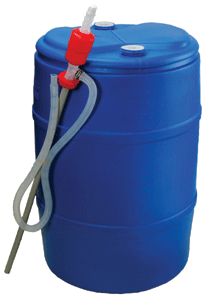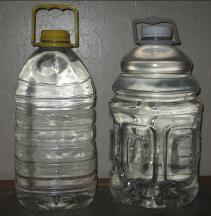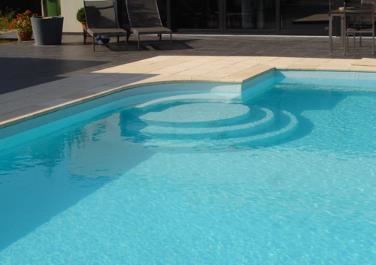|
We are fortunate to have an abundant domestic water supply that pipes clean water directly to our homes. Situations may arise, however, that can interrupt or contaminate this supply of safe drinking water. Some of these situations may include earthquakes, hurricanes, flooding, hazardous material spills, terrorist attacks, disease, strikes, etc… Some disasters, like earthquakes may rupture water mains and create a water shortage for days or even weeks.
Clean drinking water is the single most important item you should include in your food storage reserve. Most experts believe that you should store 1 gallon of water / person / day. (2qt. for drinking, & 2 qt. for food preparation / cleaning purposes) and enough water to last 2 weeks. That comes to 14 gallons per person. I believe this number is too low. Babies, children, nursing-mothers, the sick, and the elderly will need more than 2 qt. per day. Also, if the need arises that you must rely on your water storage, there is an excellent chance that you will be in an emergency situation. Such a situation may require you to be more active than you normally are, thus increasing your daily water requirement. Remember, that as we live in the desert, our daily water requirement is even greater. I would recommend storing no less than 2 gallons of water / person / day or 28 gallons of water for each person for your 14 day supply. If you have the means, store as much water as possible.
|



|
Containers
The easiest way to store the bulk of your water is in 55 gallon, polyethylene (plastic) water barrels. These can be found on the internet for about $45 or obtained locally from food storage or container companies. Make sure that whatever containers you use, that they are food grade quality. 55 gallon barrels are often available through companies that distribute beverages or syrups (Coke, Pepsi). If you clean them well, they can provide a good container that costs considerably less than a new one. Be aware that the flavor or odor of the syrup can leach into the plastic and by storing your water in these containers, the syrup flavor may be reintroduced to your water. The flavor will diminish each time you refill the barrel. You may want to select a used container that held something you wouldn't mind tasting or smelling in your water. (Lemon-Lime Soda as opposed to Soy Sauce) 55 gallon drums are a good water storage option as long as you are staying at home. If you decide to be mobile, they are too large, heavy and awkward to transport. 1 gallon of water weighs approximately 8.3 lbs. A 55 gallon drum will weigh about 460 lbs. In addition to your 55 gallon drums, store water in smaller, portable containers. Some possible portable storage containers include: 2-liter soda bottles, 1 gallon apple juice bottles, and 5 gallon water jugs. Make sure that the bottles you select are food grade quality and have tight fitting screw-cap lids. Opaque containers are best. Translucent containers may allow algae growth, but rotating your water every 6-12 |
|
months will reduce this risk. Do not use milk jugs. Milk jugs do not seal well and are bio-degradable. They will break down within 6 months. Store enough water in these “portable” containers to supply each person 2 gallons for 3 days (72-hours). Portable water containers also make refilling at streams, water trucks, or emergency water stations more practical. Try to avoid using glass or metal containers. Glass and metal containers are heavier than plastic and glass is more easily broken. Metal containers can give water a metallic taste. Water stored in metal containers should not be treated, prior to storage, with chlorine since the chlorine compound is corrosive to most metals.
|
|
Water Storage Notes
¨ Stored water should be checked occasionally. If any changes, such as cloudiness or an odor are noted, replace the water and treat as before. ¨ One of the things that affect the taste of water in long term storage is it "going flat". This occurs when your stored water sits still and loses the oxygen trapped between its molecules. You can improve the taste by pouring the water back and fourth between containers to aerate it or by beating it with a hand egg beater. ¨ Store some powdered drink mixes (kool-aid, lemonade, etc.) to add to your water. Children (and some adults) need some encouragement to drink their daily requirement of water. ¨ Other sources of water available in emergency situations are the water heater, water softener containers, and the water storage area of the toilet, water pipes, ice in the freezer, etc. ¨ If you have freezer space, storing some water in the freezer is a good idea. If you lose electricity, the frozen water will help keep foods in your freezer frozen until the power is restored. Make sure you leave 2 to 3 inches of space in containers because water expands as it freezes. ¨ If supplies run low, never ration water. Drink the amount you need today, and try to find more for tomorrow. You can minimize the amount of water your body needs by reducing activity and staying cool. Using Swimming Pool Water |
|
Do not rely on your pool water. Consider it as “backup”. Maintaining your pool at a free residual chlorine level of 1.0-2.0ppm will prevent the growth of any microorganisms. The biggest problem with drinking swimming pool water is the added impurities such as dirt, body oils, lotions, sweat, etc. If you decide to drink pool water, have pool chlorine testers available. The water you drink should have a free residual chlorine level of 5ppm. If at all possible, boil pool water, let cool and then a free residual chlorine level of 3ppm is acceptable. Consider using a backpacking water filter as an added precaution. The best practice is to use your pool water for hygiene needs and for flushing your toilet. Leave your other water storage for drinking only.
Note: In many locations, you do not own the water in your swimming pool. The city can come and claim it at anytime during an emergency. Don’t rely on having it. |

|
Water Storage |


